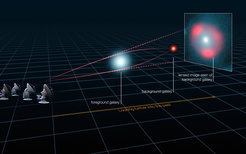Stellar baby boom
Astronomers observe starburst galaxies in early space with the ALMA telescope – and discover the most distant detection of water published to date

The most intense bursts of star birth are thought to have occurred in the early Universe, in massive, bright galaxies. These starburst galaxies convert vast reservoirs of cosmic gas and dust into new stars at a furious pace — many hundreds of times faster than in stately spiral galaxies like our own galaxy, the Milky Way. By looking far into space, at galaxies so distant that their light has taken many billions of years to reach us, astronomers can observe this busy period in the Universe’s youth.
“The more distant the galaxy, the further back in time one is looking, so by measuring their distances we can piece together a timeline of how vigorously the Universe was making new stars at different stages of its 13.7 billion year history,” said Joaquin Vieira (California Institute of Technology, USA), who led the team and is lead author of the paper in the journal Nature.
The international team of researchers first discovered these distant and enigmatic starburst galaxies with the US National Science Foundation’s 10-metre South Pole Telescope (SPT) and then used ALMA to zoom in on them to explore the stellar baby boom in the young Universe. They were surprised to find that many of these distant dusty star-forming galaxies are even further away than expected. This means that, on average, their bursts of star birth took place 12 billion years ago, when the Universe was just under 2 billion years old — a full billion years earlier than previously thought.

Two of these galaxies are the most distant of their kind ever seen — so distant that their light began its journey when the Universe was only one billion years old. What’s more, in one of these record-breakers, water is among the molecules detected, marking the most distant observations of water in the cosmos published to date.
The team used the unrivalled sensitivity of ALMA to capture light from 26 of these galaxies at wavelengths of around three millimetres. Light at characteristic wavelengths is produced by gas molecules in these galaxies, and the wavelengths are stretched by the expansion of the Universe over the billions of years that it takes the light to reach us. By measuring the stretched wavelengths, astronomers can calculate how long the light’s journey has taken, and place each galaxy at the right point in cosmic history.
“ALMA’s sensitivity and wide wavelength range mean we could make our measurements in just a few minutes per galaxy — about one hundred times faster than before,” said Axel Weiss (Max Planck Institute for Radio Astronomy in Bonn, Germany), who led the work to measure the distances to the galaxies. “Previously, a measurement like this would have been a laborious process of combining data from both visible-light and radio telescopes.”
In the majority of cases, the ALMA observations alone could pinpoint the distances, but for a few galaxies the team combined the ALMA data with measurements from other telescopes, including the Atacama Pathfinder Experiment (APEX) and ESO’s Very Large Telescope [1].

The astronomers were using only a partial array of 16 of ALMA’s full complement of 66 giant antennas, as the observatory was still under construction at an altitude of 5000 metres on the remote Chajnantor Plateau in the Chilean Andes. When complete, ALMA will be even more sensitive, and will be able to detect even fainter galaxies. For now, astronomers targeted the brighter ones. They took advantage of a helping hand from nature, too: using gravitational lensing, an effect predicted by Einstein’s general theory of relativity, where light from a distant galaxy is distorted by the gravitational influence of a nearer foreground galaxy, which acts like a lens and makes the distant source appear brighter.
To understand by precisely how much this gravitational lensing brightened the view of the galaxies, the team made sharper images of them using more ALMA observations at wavelengths of around 0.9 millimetres.
"These beautiful pictures from ALMA show the background galaxies warped into multiple arcs of light known as Einstein rings, which encircle the foreground galaxies," said Yashar Hezaveh (McGill University, Montreal, Canada), who led the study of the gravitational lensing. “We are using the massive amount of dark matter surrounding galaxies half-way across the Universe as a cosmic telescope to make even more distant galaxies appear bigger and brighter.”
Analysis of the distortion reveals that some of the distant star-forming galaxies are as bright as 40 trillion (40 million million) Suns, and that gravitational lensing has magnified this by up to 22 times.
“Only a few gravitationally lensed galaxies have been found before at these submillimetre wavelengths, but now SPT and ALMA have uncovered dozens of them.” said Carlos De Breuck (ESO), a member of the team. “This kind of science was previously done mostly at visible-light wavelengths with the Hubble Space Telescope, but our results show that ALMA is a very powerful new player in the field.”
“This is a great example of astronomers from around the world collaborating to make an amazing discovery with a state-of-the-art facility,” said team member Daniel Marrone (University of Arizona, USA). “This is just the beginning for ALMA and for the study of these starburst galaxies. Our next step is to study these objects in greater detail and figure out exactly how and why they are forming stars at such prodigious rates.”
HOR / NJ


